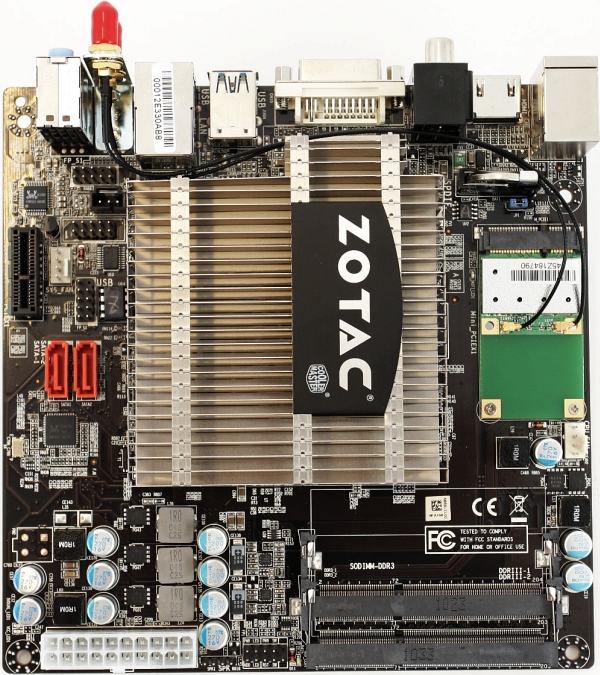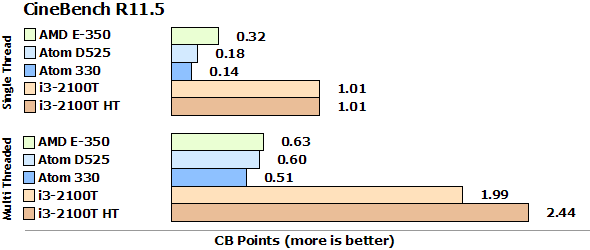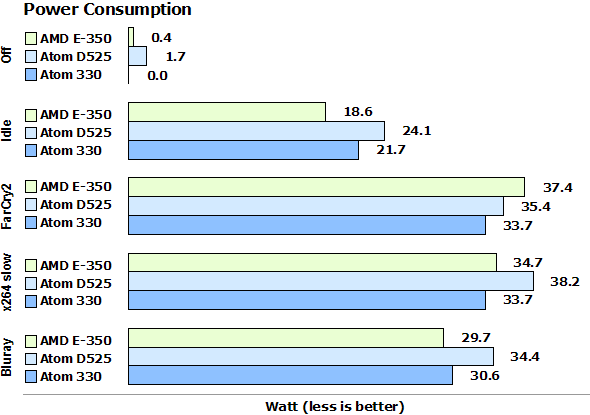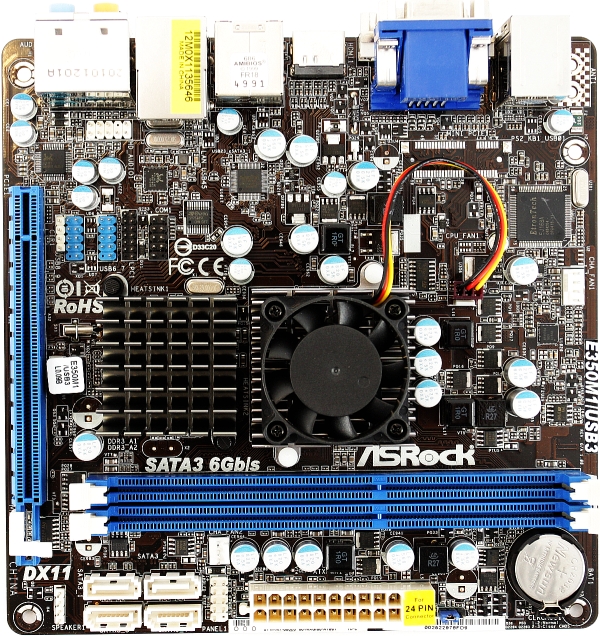Index


Review: Intel Atom is still dead
After our first E-350 Brazos review some of our readers were outraged that we have used Windows XP instead of Windows 7. More importantly we had no time to get an Intel D525 board with ION2, which would be a more serious match instead of the Atom 330+ION we were forced to use. Today we got an Zotac ITXION-S which uses an Atom D525 and an ION2. It's the same chip found on the G210 with 16 shaders and clocks with 535MHz for the core and 1230MHz for the shaders. The downside of any ION2 is the connection just with one PCIe x1 lane to the chipset, so limiting the bandwidth to a mere 250MB/s. To compensate for that, all boards include 512MB DDR3 memory, so the GPU has not go via the chipset to access memory which would hurt the performance. The internal graphics of the E-350 which is called Radeon 6310, consists of 80 cores but does only clock with 500MHz. While that may not be a problem for the majority of applications, the 500MHz clock also limits the UVD3 engine. The Atom D525 is clocked at 1.8GHz, has 2x 512kB 2nd level cache and both CPU cores are now on one die. The AMD E-350 clocks with 1.6GHz and has a also 2x 512kB L2 cache.

Testbed:
ASRock E350M1/USB3 (provided by ASRock)
AMD E-350/A50M
Zotac ITXION-S (provided by DiTech)
Intel Atom D525/NM10/nVidia G210M aka Ion2
ASRock Ion330-HT BD (provided by ASRock)
Intel Atom 330/iCH7/GeForce 9400M aka Ion
Memory:
G.Skill SO-DIMM 4GB Kit PC3-106667 (provided by G.Skill)
1067MHz CL8-8-8-23 CR1T 1.35V
G.Skill Eco 4GB Kit PC3-12800 (provided by G.Skill)
1333MHz CL7-7-7-20 CR1T 1.35V
Hard disk:
Mushkin Callisto Deluxe 60GB (provided by Mushkin)
Case:
ITX Case with 80W PSU found somewhere
OS:
Windows 7 Ultimate SP1 x64
The ASRock E350M1/USB3 board
It's essential the same board as the previous tested E350M1 with the difference that it consists of two USB 3.0 ports and now all capacitors are solid ones.
The backpanel is ASRock standard with a useless PS/2 port and equally obsolete VGA connector. Sorry folks, it just doesn't make sense to convert a digital signal into analog, which is then converted back to digital inside the monitor except if you are one of a handful of people still using CRT monitors. There would be also be space enough to fit two more USB 2.0 ports.
Zotac ITXION-S board:
The Zotac board is not designed as a desktop replacement but more for HTPC use. It uses high-end components such as Tantalum capacitors and high-end chokes. While it does support DDR3 you have to use the more expensive SO-DIMMs because due to the usage of the ION2 chips with memory, the space is very limited. The board also contains a WLAN mini-PCIe card, which is a neat feature.
The backpanel is rather standard, but of course with two antenna outputs. But while the space is cramped also this board has two USB 3.0 ports on the panel.
Due to the space contraints Zotac had to put some integrated parts on the backside.
Benchmarks
Today we did the same benches as we did in the Sandy Bridge review. As you will see, especially the single thread performance of the Atom is about half of the E-350, but in multi-threaded applications the performance is quite on par, regardless of the 200MHz higher clock of the Atom. In the gaming department the ION2 and the Radeon 6310 are also on par, but only because the ION2 benefits from 512MB of dedicated DDR3 memory.


Of course the comparision with the i3-2100T is unfair, because here we used a Radeon HD6870.






Because the FarCry2 bench did not allow for low settings in DX10, we had to settle for DX9 with Low/Low/Low and the rest of the settings are medium.
Power-Consumption
While the ASRock ION 330HT box is an original one, we used a ITX case with 80W PSU for the E-350 and D525. We also removed the WLAN card of the Zotac board, so Zotac has no disadvantage due to an extra card. First, we take a look at power efficiency in Cinebench, meaning under very high and threaded loads.


The efficency of both the Intel Atom and the AMD E-350 are dissapointing. Any Intel desktop CPU is more efficient and of course ARM is also miles ahead.

In the power consumption department the old Atom/ION combination still leads slightly but just about 4W more for either Atom D525+ION2 and E-350 are not that bad either. The Zotac board draws 1.7W when switched off, which is dissapointing, while the ASRock ION box did the correct thing and does not use any energy at all. The blu-ray test was done with a file on the SDD, so using a real drive would add about 7-8W.
Conclusion
Intel Atom D525 + ION2 vs AMD E-350:
Overall both boards did well. While the performance is similar in multi-threaded application (except WinRAR where AMD is miles ahead) the AMD E-350 shines in the single-threaded department. Especially browers and even Windows feel faster and more responsive. The UVD3 engine is good enough to play all standard formats and blu-rays without a problem. Just 1080p with 60fps is out of the question because the GPU does not clock high enough. If there are codecs which get no hardware acceleration and have 1080p resolution both CPUs are too weak to perform seamless playback. The ION2 is faster (due to the higher clock) at hardware accelerated playback reducing the CPU load more compared to the E-350 but 16 cores is just too few to impress in games. The real difference between the two is now the price. The AMD E-350 boards got cheaper, while the Atom/ION2 combo still costs a lot and this particular board sells for about €130, which is a bit too expensive for our taste.
Zotac ITXION-S:
The board is superbly built and the passive fan wasn't as hot as we expected. The biggest downfall of this board is it's price currently at €144,-/$190,-. We would take any E-350 board over any Atom board. Zotac does offer a passive E-350 board as well, the Zotac Fusion ITX but with about €123,-/$169,- it's considerable more expensive compared to ASRock and uses SO-DIMMs, but it offers excellent build quality and WLAN.
ASRock E350M1/USB3:
The ASRock E350M1/USB3 is cleary designed as a desktop replacement. While the inclusion of the USB 3.0 and all solid capacitors is an welcomes edition, the board is still using a 4cm active fan which gets audible under load. It's not insanely loud as we feared, but using the computer on your desktop it may get on your nerves. If you use it as an HTPC, so your case stays near the TV or monitor, you won't notice it. It's essential to run the fan mostly at highest speed, because under load the E-350 may experience temperature problems when your case is really small and the APU will clock down. ASRock is working on a BIOS which will adjust the fan-speed according to the CPU temperature, so we recommand to take a look in their beta-zone. At a price for about €93,-/$115,- the board is not a bargain, but it is still affordable as a HTPC or surfstation. If you uses it as we described, the downside to the active fan can be overlooked.








